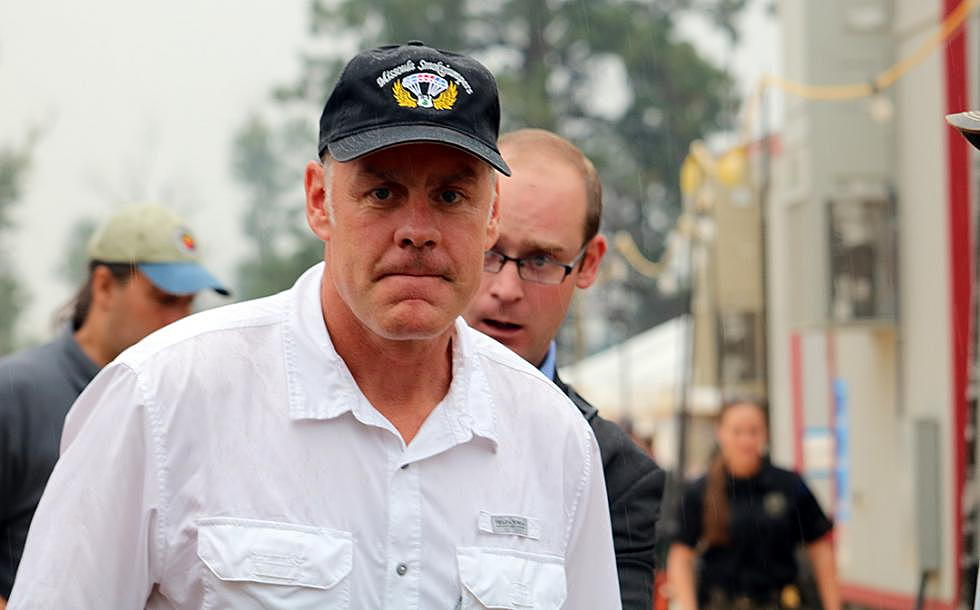
Zinke submits monument recommendations to Trump, withholds details from public
U.S. Interior Secretary Ryan Zinke on Thursday filed his report with President Donald Trump outlining the fate of 27 national monuments, though he did not make the recommendations public.
Zinke, who was in Montana on Thursday for a Lolo Peak fire briefing, declined to answer questions from the media regarding the recommendations he submitted to Trump earlier in the day.
“The report was sent to the White House,” one Interior representative told the Missoula Current during a fire briefing in Florence. “You can see the press release, and that's the statement.”
According to CNN and the Associated Press, Zinke's report did not recommend eliminating any of the national monuments he was directed to review. But boundary changes to several monuments may be likely, possibly opening federal lands to energy production.
"Sec. Zinke needs to be clear about what he's recommending for the national monuments under review,” said John Todd, conservation director of the Montana Wilderness Association. “We deserve to know what his recommendations are."
Zinke spent Thursday in western Montana with Agriculture Secretary Sonny Perdue, Sen. Steve Daines and Rep. Greg Gianforte, all Republicans, where he discussed the future of forest management. Before the press briefing, the media was told he would not take questions regarding national monuments and Thursday's report.
In a summary of that report, which was made public but avoided any specific recommendations, Zinke said none of the sites will revert to private ownership. Public access for uses such as hunting, fishing or grazing will be maintained or restored.
The summary also suggested that Trump has the authority to modify national monuments at his own discretion, including those made after 1996 that are greater than 100,000 acres in size and were made “without adequate public consultation.”
“This is far from the first time an examination of the scope of monuments has been conducted,” the report said. “Existing monuments have been modified by successive presidents in the past, including 18 reductions in the size of monuments, and there is no doubt that President Trump has the authority to review and consider recommendations to modify or add a monument.”
In April, Trump directed Zinke to study 27 national monuments to gauge whether their size, boundaries and scope conform to parameters in the Antiquities Act. Trump believes past presidents abused their discretion and designated monuments to block public land from resource extraction.
In his summary, Zinke said the 2.4 million comments received by the Department of Interior since April were overwhelmingly against any alteration of the national monuments. However, he suggested many of the comments were formulated by several groups.
“Comments received were overwhelmingly in favor of maintaining existing monuments and demonstrated a well-orchestrated national campaign organized by multiple organizations,” Zinke said.
The summary added that monument opponents supported changes or elimination to protect traditional uses, including cattle grazing, timber production, mining and motorized recreation.
“There’s an expectation we need to look out 100 years from now to keep the public land experience alive in this country,” Zinke told the Associated Press. “You can protect the monument by keeping public access to traditional uses.”
Thursday's vague announcement drew widespread criticism from those with an eye on the issue, including the League of Conservation Voters and its president, Gene Karpinski.
“Secretary Zinke’s so-called review of parks and monuments has been a complete sham, with arbitrary criteria for ‘pardoning’ some national monuments while attacking others,” Karpinski said. “This exercise was nothing more than a pretext for selling out our public lands and waters as a political favor to Big Oil and other special interests who want to pad their profits.”
In Missoula, a group of protesters lined the highway traveled by Zinke and Perdue to protest recommendations that could result in the downsizing of several monuments. They too questioned the study's need to remain secret.
"From the get-go, it's been a waste of taxpayer dollars and valuable time for land managers,” said Sophie Moon, chair of the MontPIRG Board of Directors. “We don't know how the review's being conducted, whose voice will be heard, or what is driving Zinke's decisions.”
Several groups expressed alarm that Zinke would discount the feedback of millions of Americans while refusing to disclose his recommendations.
“Any recommendation from Secretary Zinke to shrink national monuments is hypocritical at best and ruinous at worst,” said Michael Brune, executive director of the Sierra Club. “Secretary Zinke claims to support public lands, but now we know he’s just one more Trump Administration stooge for polluting special interests.
